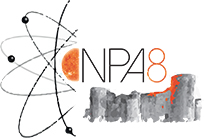Speaker
Giovanni Francesco Ciani
(GSSI)
Description
Heaviest nuclei (A > 58) are synthesized by sequential neutron capture reactions. There are two main processes, depending on their time scale compared with the beta decay lifetime: these are the so called slow (s) and rapid (r) processes. Both produce about half of the stable isotopes beyond iron in the Universe [1].
Focusing on the s process, these take place in low mass (1 − 3M⊙) Asymptotic Giant Branch (AGB) stars, and their main neutron source is the identified in the 13C(α,n)16O reaction.
The temperatures involved in these processes are in the range between 90 - 100 MK, which roughly correspond to Gamow energies between 180 and 200 keV. At present, the cross section within the Gamow peak is uncertain by almost one order of magnitude, having a large impact on stellar models.
Currently, direct measurements of the reaction are done at energy above the Gamow window [2, 3]. Extrapolations or indirect measurements have been used to extend the cross section up to lower energies [4], but these need a renormalization or theoretical inputs.
The low background condition in the LNGS deep underground laboratory, combined with the LUNA accelerator [5, 6] offers a unique possibility to perform this measurement with a direct technique at lower energies.
In this talk, I will present the current state of the project, including neutron detectors perfor- mance and enriched 13C solid target characterization.
Author
Giovanni Francesco Ciani
(GSSI)
Co-authors
Dr
Izabela Anna Kochanek
(LNGS)
Dr
Laszlo Csedreki
(INFN Laboratori Nazionali del Gran Sasso)

